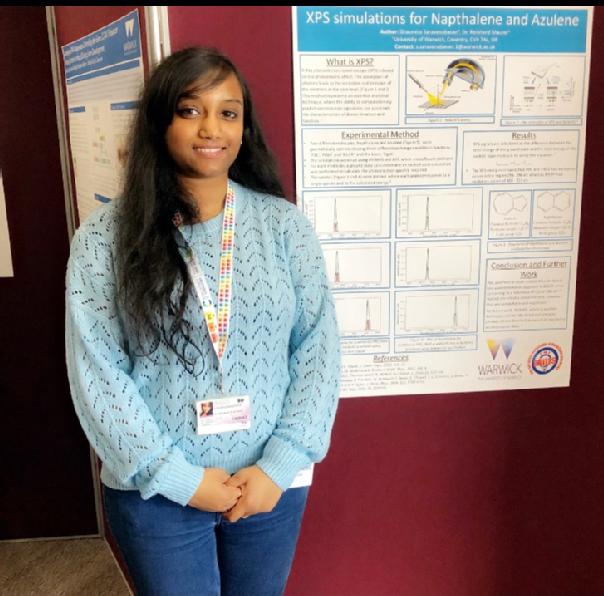Shaumica Saravanabavan
Final Year PhD student as part of the AS CDT. My main research interests include the following:
- Photoelectrocatalysis
- Looking to acquire more efficient fuel for long-distance space missions
- Finding alternative life support system for space travel and utilising microgravity for water splitting reactions
PhD Project
PhD title "Solar-assisted oxygen and fuel production for long-term space travels and our moon habitats"
My PhD project is focusing on providing more reliable and efficient oxygen and fuel generation for space travel under the supervision of Dr. Katharina Brinkert (Department of Chemistry) and the European Space Agency (ESA). This is by the use of minimal resources and by producing minimal waste. I am based in the MAS building in the Department of Chemistry, University of Warwick and hope to gain expertise skills in using some of the equipment in the lab through the facilities and training provided by the CDT.
At present, the International Space Station, ISS, uses an Oxygen Generation Assembly and a Carbon Dioxide Reduction Assembly. This current device enables water oxidation and recycles carbon dioxide separately, but only 50% of the oxygen can be recovered this way. For the realisation of long-term space travels a recovers of 90% oxygen is essential. The successful implementation of an efficient photoelectrochemical water splitting cell would therefore not only be a highly desirable approach to solving the energy challenge on Earth; an efficient air revitalization system generating a constant flux of oxygen while simultaneously recycling carbon dioxide and providing a sustainable fuel supply could also complement currently existing life support technologies for the ISS and long-term space missions, where a regular resupply from Earth is not possible.
The overall aim of this PhD project is to realise a monolithic device to allow for unassisted, light-induced production of oxygen while simultaneously reducing carbon dioxide to hydrocarbons (fuels) in reduced gravitational environments using technologically-advanced III-V tandem-and triple-junction semiconductors coated with electrocatalysts. These systems will be studied in experiments at the Bremen Drop Tower, focusing particularly on the J-V characteristics and efficiencies of the respective half-cells during 9.2s of free fall.
A particular drawback in reduced gravitational environments is the absence of buoyancy resulting in the formation of gas bubbles in front of the electrode surface. This problem is addressed by adjusting the nanotopography of the electrocatalyst forming catalytic hot-spots on the electrode surface.This prevents gas bubble coalescence and different electrolyte compositions are investigated.
Academic Background
| Qualification | Year |
| PhD in Analytical Sciences | 2020 - 2024 |
| MSc by Research in Theoretical and Computational Chemistry | 2019 - 2020 |
| BSc in Chemistry with Medicinal Chemistry | 2016 - 2019 |
Previous Research
MSc thesis 'Ab initio Calculatons of XPS Simulations on Organic Molecules and Solid Interfaces'
Supervised by Dr. Reinhard Maurer (Department of Chemistry)
The aim of my research masters was to evaluate different thereotical methods used to calculate the XPS binding energies for a number of different molecules. Here, the use of the exchange correlation functional and the basis set was changed for a more comparative measure. The software packages of FHI-aims and CASTEP were used to compare the outputs. The work in Maurer's group consisted of some collaborations with emphasis on bigger molecules such as diamond. Predicting the accuracy of such theoreotical methods allows to compare this to experimental work undertaken and offers an analysis of the theoretical XPS methods opposed to the experimental XPS energies obtained.
Undergraduate Research Support Scheme - URSS 'XPS Simulations for Naphthalene and Azulene'
Supervised by Dr. Reinhard Maurer (Department of Chemistry)
Here, the 10-week summer placement allowed me to get acquainted with using Python Scripting, plotting using Matplotlib, using the LINUX infrastructure and performing XPS simulations on aromatic gas-phase molecules. I was able to compare the results obtained to experimental spectra for Naphthalene and Azulene and to previous theoretical XPS calculations undertaken.

Extra-curricular Activities
I enjoy teaching others, and therefore demonstrating in the undergraduate teaching laboratories during my PhD. I am trilingual in Tamil, German and English and enjoy poetry.
Currently, I am a postgraduate SSLC member for AS CDT and want to contribute to improvements to student wellbeing side of things and plan more social events.
Publications
Saravanabavan S., Coulthard C. T., Kaur M., Brinkert K.* (2022). Catalysis in Space Environments. doi.org/10.1002/9783527830909.ch7 In: Hessel V., Stoudemire J., H. Miyamoto & I. D. Fisk (Eds.). In Space Manufacturing and Resources. Wiley-VCH. ISBN: 978-3-527-83091-6

